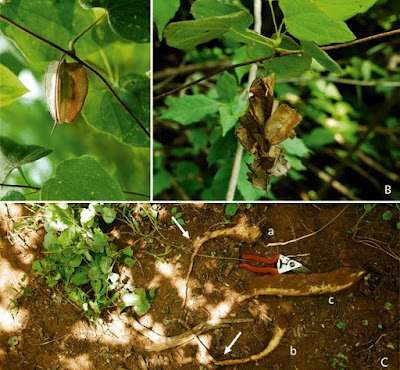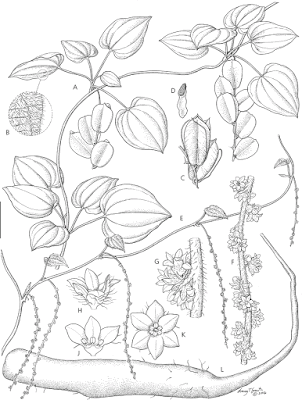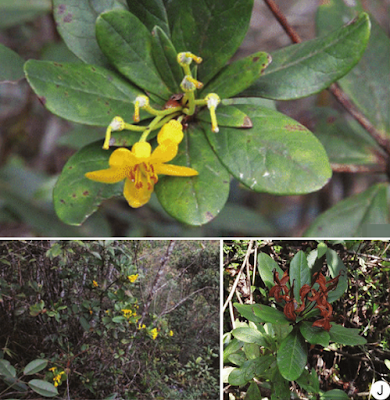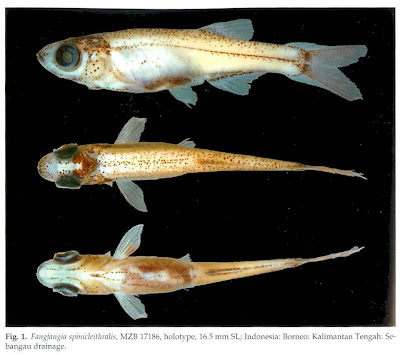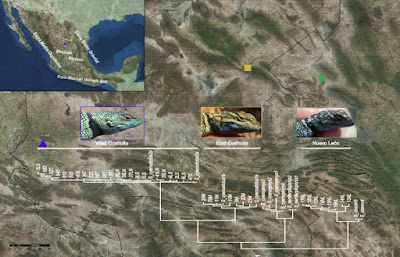[Most Recent Entries] [Calendar View]
Sunday, April 23rd, 2017
| Time | Event | ||||
| 2:56p | [Botany • 2017] Dioscorea irodensis • A New Species of Critically Endangered Edible Yam (Dioscoreaceae) Endemic to northern Madagascar and Its Conservation
Summary Morphological character data are used to show that a distinct morphotype of Dioscorea L. from the Irodo valley (East of Sadjoavato) in Antsiranana Province of Madagascar is an undescribed species, differing in its leaf arrangement, pubescence form and male inflorescence structure from all other taxa. It is described as Dioscorea irodensis Wilkin, Rajaonah & Randriamb., illustrated and a distribution map and ecological information provided. It is known from three sites, but is likely to have been eradicated from one of them. The population that has been studied in the field contains a very low number of adult plants. Tubers have been extracted for use as food at a level that appears to be unsustainable. Thus its provisional IUCN conservation status assessment is that it is critically endangered (CR). Its vernacular name in Irodo is Bemandry. Key Words: conservation, critically endangered, distribution, edible, ex situ, in situ, Madagascar, morphology, new species, yam
Dioscorea irodensis Wilkin, Rajaonah & Randriamb., sp. nov. Type: Madagascar, Antsiranana: Diana, Antsiranana II, Anivorano, Irodo, ala fady S of village towards Irodo river estuary, 12°39'6.3"S 49°31'38.2"E, ♀ fr. 8 Feb. 2015, P. Wilkin, J. A. Kennerley, F. Rakotonasolo, M. Hamido & M. Tsaratiana 1675 (holotype TAN!; isotype K!). Recognition. Tuber horizontal in soil with a curved apex (derived from digging up two plants and inferring a similar position in others from the shape of extraction holes and the Malagasy vernacular name). Leaves in clusters of up to 7 on short herbaceous branches, clustered particularly towards bases of main vegetative stems (Fig. 1A, 2B), blades thin in texture, densely pubescent below and when immature but coarse and never forming a tomentum as in Dioscorea ovinala. Plants at the locality near Irodo represented by Wilkin et al. 1674 and 1675 often have white spotting on their leaf blades which has the appearance of pathogenic infection (see Fig. 2A). Male inflorescences (Fig. 1 E, F) with irregularly spaced, spirally arranged dense cymules of 2 – 8 pedicellate flowers or rarely solitary, vs flowers (sub)sessile, or rarely with a pedicel to 0.5 mm long and solitary or in groups of 2 – 4 (D. ovinala). Fruit not inflated and fleshy during development but thin-lobed and capsular throughout, single layered at dehiscence. Restricted to a small area East of Sadjoavato in Antsiranana Province. Distribution and habitat. Endemic to the Irodo river Valley and Sahafary forest in Antsiranana Province (Map 1) at altitudes from 30 – 230 m. It is possible that the three collections from South of the village of Irodo represent two subpopulations on either side of the river as opposed to two distinct populations (the term population is used here in an ecological sense, except in the Conservation Status section), but the specimen from Sahafary forest is spatially isolated. At Irodo, it is found in semi-deciduous forest with a canopy to 10 m and a clear shrub layer, the principal canopy trees being Colvillea and Tamarindus, with Pachypodium in the shrub layer. Soil a brown sandy loam, possibly alluvial, or red sand over limestone bedrock. The Sahafary Forest specimen states that it was from scrub forest on red sand. Etymology. Named for the village of Irodo and the Irodo River valley where this species is found. Vernacular name. Bemandry in the village of Irodo. This name appears to be applied particularly to species with horizontal tubers, for example the element of Dioscorea soso Jum. & H. Perrier sensu lato with the same tuber habit. Uses. Tuber edible cooked. Rather watery following cooking and thus not fully satisfying the appetite. Dioscorea maciba, known as batatala in Irodo, is the more sought after species of the two that are found in the Irodo valley and surrounding areas. Not believed to be sold in markets but consumed usually in March/April. Paul Wilkin, James A. Kennerley, Mamy Tiana Rajaonah, Geodain Meva Huckël, Feno Rakotoarison, Tianjanahary Randriamboavonjy and Stuart Cable. 2017. A New Species of Critically Endangered Edible Yam Endemic to northern Madagascar, Dioscorea irodensis (Dioscoreaceae) and Its Conservation. Kew Bulletin. 72; 15. DOI: 10.1007/s12225-017-9677-6 | ||||
| 3:27p | [Botany • 2016] Rhododendron longipedicellatum • A New Species (Ericaceae) from southeastern Yunnan, China
Abstract A new species of Rhododendron (Ericaceae) in sect. Vireya subsect. Pseudovireya from Malipo County, Southeast Yunnan, China, Rhododendron longipedicellatum, is described and illustrated. The new species is most similar to R. rushforthii but differs in its arrangement of leaves, the shape and color of the lamina, length of the petiole and the size of the calyx lobes. It also resembles R. trancongii and R. datiandingense, but differs in its color and shape of the lamina, the leaf apex, lengths of the petiole, pedicel and stamens, and the indumentum of the ovary. Keywords: Ericaceae, Rhododendron, new species, China, Eudicots Etymology:— The epithet “longipedicellatum” refers to the relatively long pedicels of the new species. This species has almost the longest pedicels in R. subsect. Pseudovireya (Clarke) Sleumer. The Chinese name in Pinyin is “chang geng du juan”. Lei Cai, Jens Neilsen, Zhi-Ling Dao and Yong-Peng Ma. 2016. Rhododendron longipedicellatum (Ericaceae), A New Species from southeastern Yunnan, China. Phytotaxa. 282(4); 296–300. DOI: 10.11646/phytotaxa.282.4.7 | ||||
| 3:47p | [Ichthyology • 2011] Fangfangia spinicleithralis • A New Genus and Species of Miniature Cyprinid Fish (Teleostei: Cyprinidae) from the Peat Swamp Forests of Borneo
Fangfangia spinicleithralis, new genus, new species, is described from peat swamp forest habitats in Kalimantan Tengah, Borneo, Indonesia. It differs from all other cyprinids in having the anteroventral tip of the left cleithrum projecting into a strong anteriorly directed spine and a pointed posteriorly directed spine at the posteroventral aspect of each cleithrum. In addition, it can be diagnosed by the following characters: the base of the dorsal hemitrich of the first pectoral-fin ray with serrated margin, multicuspid pharyngeal teeth, ventrally directed lateral processes on vertebra 1, the high number of procurrent caudal-fin rays (14-18 dorsally, 11-15 ventrally), absence of scales with the exception of six or seven tubular lateral line ossicles, and the greatly elongated middle radials in the anal fin, which may reach half the length of proximal radials. Fangfangia, new genus Etymology. The new genus is named after the late Fang Fang, a passionate and productive cypriniform researcher, who left us too early, honouring her contribution to danionine taxonomy and phylogeny. Gender feminine. Fangfangia spinicleithralis, new species Distribution. Fangfangia spinicleithralis is presently known only from the type locality in Sebangau peat swamp forest, Kalimantan Tengah, Borneo, Indonesia. Etymology. The species name spinicleithralis, an adjective, is derived from the Latin words spina, thorn, and cleithralis, belonging to the cleithrum(the main element of the dermal shoulder girdle). It refers to the unique pointed anterior and posterior spines on the cleithrum of this species. Britz, R., Kottelat, M., & Tan, H.H. 2011. Fangfangia spinicleithralis, A New Genus and Species of Miniature Cyprinid Fish from the Peat Swamp Forests of Borneo (Teleostei: Cyprinidae). Ichthyol. Explor. Freshwaters. 22 (4): 327-335. | ||||
| 4:00p | [Herpetology • 2017] Species Delimitation of the Blue-spotted Spiny Lizard within A Multilocus, Multispecies Coalescent Framework, Results in the Recognition of A New Sceloporus Species; Sceloporus gadsdeni
Highlights • Reciprocal monophyly supported clades were found for Sceloporus cyanostictus. • Parametric coalescent-based method confirms two different lineages. • A new species of Sceloporus is recognized and described. Abstract Species delimitation is a major topic in systematics. Species delimitation methods based on molecular data have become more common since this approach provides insights about species identification via levels of gene flow, the degree of hybridization and phylogenetic relationships. Also, combining multilocus mitochondrial and nuclear DNA leads to more reliable conclusions about species limits. Coalescent-based species delimitation methods explicitly reveal separately evolving lineages using probabilistic approaches and testing the delimitation hypotheses for several species. Within a multispecies, multilocus, coalescent framework, we were able to clarify taxonomic uncertainties within S. cyanostictus, an endangered lizard that inhabits a narrow strip of the Chihuahuan Desert in Mexico. We included, for the first time in a phylogenetic analysis, lizards from the three populations of S. cyanostictus recognized so far (East Coahuila, West Coahuila and Nuevo León). Phylogenetic analysis corroborates the hypothesis of two separately evolving lineages, i.e. the East and West Coahuila populations, as proposed in a previous study. We also found a distant phylogenetic relationship between the lizards from Nuevo León and those of East and West Coahuila. Finally, based on the species delimitation results, we propose and describe a new species of Sceloporus: Sceloporus gadsdeni sp. nov. Keywords: BP&P; Chihuahuan Desert; Molecular data; Systematics; Sceloporus; Taxonomic uncertainties
Sceloporus gadsdeni Castañeda-Gaytán & Díaz-Cárdenas sp. nov. (Lagoon Spiny Lizard) Diagnosis: This species differs from S. cyanostictus in the dorsal color pattern (live), which is completely green with two dominant tonalities (metallic green and turquoise). The ventral pattern has a blue patch that joins in the middle of the belly and the chest with black borders in males; in contrast, in S. cyanostictus the chest and undersurfaces of arms are pale grayish blue with melanin specks, each flank has a poorly defined bluish black belly patch sometimes without contact in the middle of the belly. According to currently available published information, S. cyanostictus from eastern Coahuila has 6 superciliars and 6 infralabials (Axtell and Axtell, 1971), while S. gadsdeni has 4 superciliar scales on each side of the head and 5 infralabials with uncertainty on this character due to sample size (Table 2). The distribution of S. gadsdeni is restricted to the Sierras Texas, Solis and San Lorenzo mountain ranges in southwestern Coahuila, and this species inhabits rock walls, boulders and canyons. These mountains are separated from the location of S. cyanostictus by ca. 190 km as the crow flies and immersed within the low Mayran Basin. Etymology: This species is named in honor of Hector Gadsden, a researcher who has made praiseworthy contributions to the ecology and conservation of the herpetofauna of La Comarca Lagunera and the Chihuahuan Desert. The suggested common name alludes to its restricted distribution within the La Comarca Lagunera region. Brenda Díaz-Cárdenas, Eduardo Ruiz-Sanchez, Patricia Castro-Felix, Gamaliel Castañeda-Gaytán, Sergio Ruiz-Santana and Héctor Gadsden. 2017. Species Delimitation of the Blue-spotted Spiny Lizard within A Multilocus, Multispecies Coalescent Framework, Results in the Recognition of A New Sceloporus Species. Molecular Phylogenetics and Evolution. In Press. DOI: 10.1016/j.ympev.2017.04.004 |
| << Previous Day |
2017/04/23 [Calendar] |
Next Day >> |
